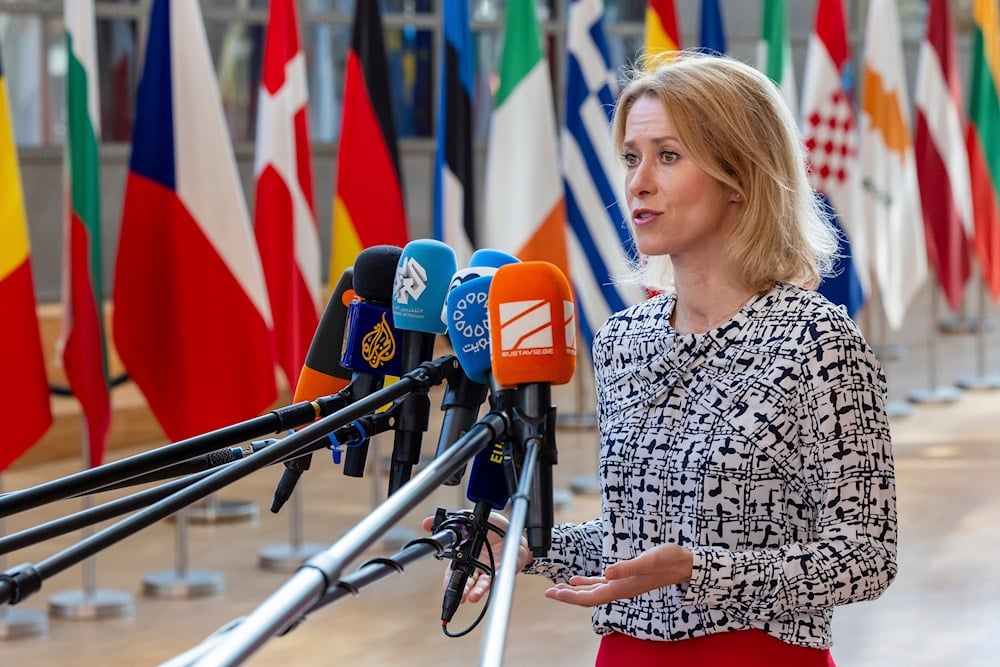Russia must pay reparations before frozen assets are returned: Kallas
EU's Kaja Kallas says frozen Russian assets won't be released until reparations for Ukraine are paid.
-

European Union foreign policy chief Kaja Kallas talks with journalists as she arrives for an EU foreign ministers meeting at the EU Council building in Brussels, Tuesday, July 15, 2025 (AP)
Kaja Kallas, European Foreign Policy chief, announced on Saturday that the bloc cannot envision returning any frozen Russian assets unless Moscow fulfills its responsibility to compensate Ukraine for the war damage.
"We can't possibly imagine that ... if ... there is a ceasefire or peace deal that these assets are given back to Russia if they haven't paid for the reparations," Kallas stated ahead of an EU foreign ministers' meeting in Copenhagen.
EU Foreign Affairs ministers gather in Copenhagen today.
— Kaja Kallas (@kajakallas) August 30, 2025
On our agenda:
🔹 Russian aggression against Ukraine
🔹 Issue of frozen assets
🔹 Situation in the Middle East
🔹 Working methods
My doorstep ↓ pic.twitter.com/B4vhExElYS
Following the escalation of the war in Ukraine in 2022, the EU froze around €210 billion ($245 billion) in Russian sovereign assets under sanctions. Most of these assets, primarily government bonds and foreign currency reserves held by Russia's Central Bank, are managed by Euroclear, a Belgium-based central securities depository.
Over time, matured bonds have been converted to cash, which remains immobilized. These assets now generate substantial windfall profits, which the EU has begun channeling to Ukraine. Euroclear alone reported earnings of €6.9 billion in 2024 from these holdings.
Calls for full seizure meet resistance
Several EU states, particularly Poland and the Baltic countries, support the full seizure of Russian funds to directly finance Ukraine's reconstruction. However, key EU powers, including France, Germany, and Belgium, remain opposed. They stress legal concerns, warning that seizing the principal could undermine international legal norms and financial stability.
Belgian Prime Minister Bart De Wever had previously labeled the idea of seizure as "very dangerous from a legal perspective," while German Chancellor Friedrich Merz cautioned about adverse effects on the capital markets.
Using profits instead of principal
The EU has so far opted to use the profits generated from the frozen Russian assets. Under the G7's Extraordinary Revenue Acceleration (ERA) Loans initiative, Ukraine receives substantial funding backed by future earnings on these assets. A recent EU tranche under this framework totaled €3 billion in January 2025, managed through the Ukraine Loan Cooperation Mechanism (ULCM).
This strategy avoids legal complexities while ensuring sustained financial support for Kiev. Projections estimate that these frozen reserves could yield €15-16 billion in interest by 2027, though this could diminish if eurozone interest rates decline.
The French Defense Ministry said today that #France will use a share of 1.4 billion euros ($1.5 billion) in revenue from frozen Russian assets to buy military equipment for #Ukraine.
— Al Mayadeen English (@MayadeenEnglish) September 7, 2024
"Alongside other (#EU) member states, the ministry... will take part in implementing the new… pic.twitter.com/r0IwaQISdA
Ongoing legal, political challenges
Despite the profits-based approach, debate continues within the EU. Legal scholars argue that international law generally protects sovereign assets from confiscation. Some experts propose circumventing these protections through legislative action or enforcing international judgments, but consensus remains elusive.
Political obstacles also loom. EU sanctions must be renewed every six months, requiring unanimity. Hungary has already threatened vetoes, casting doubt on long-term enforcement. In March 2025, Budapest narrowly backed down after nearly blocking a renewal.

 3 Min Read
3 Min Read








